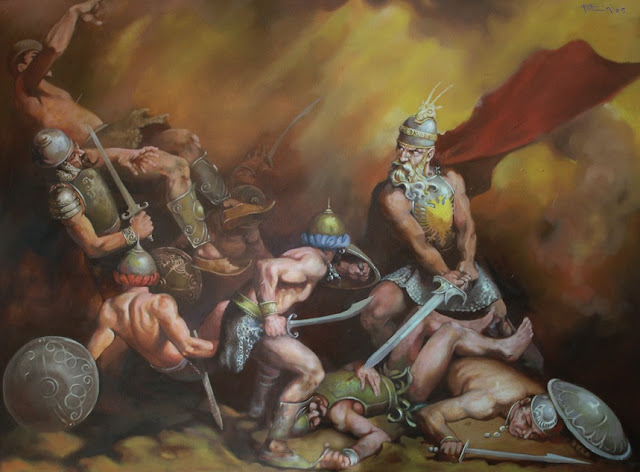 |
| A painting when Skanderbeg fights with the Ottomans (archive) |
"The document is written on parchment. It has been preserved quite well ", claims Ahmeti. The document has dimensions: 68 x 92.5 cm. Two original seals are also hung on it. The first, the state seal of Skanderbeg and the second, that of the notary Johannes Borcius de Grillis. "We have also been informed of a copy of this mandate which is also preserved in the Vatican Secret Archive, in the Fund: Diversa Cameralia, vol. 30, f. 134r-v. This copy is accurate and very faithful, without any omission on the part of the descriptor ", - affirms the researcher Ahmeti.
When did Skanderbeg become king?
Rodon was chosen to sign the king's mandate. As noted in the original, the mandate was issued on October 28, 1458. It is addressed to Pope Pius II, who had less than two months to begin his pontificate (Pius II begins his pontificate on September 3, the year 1458, and dies on 15 August ,1464). "Pope Pius was known as a fierce fighter for the protection of the Christian religion even as a Cardinal," writes the scholar Ahmeti. Another important moment that draws attention to this mandate is the statement of the public notary Johannes Borcius de Grillis that he "by order and authorization of the king…" ie He calls Skanderbeg King. "This moment is very significant because even in the hanging state seal that accompanies this document we find written the text: Sigil (um) o Regni (ae) o Macedonia (e) o et Albania (e), which in the Albanian language will to be: The Seal of the Kingdom of Albania and Macedonia”.
Skanderbeg inherits the office from his father, Gjon
From the documents, it is thought that the chancellery office that was near Skanderbeg was a continuation of the same office, which functioned under his father Gjon Kastrioti. According to Ahmeti, it is said that this office dates back at the beginning of the XIV century. "Obviously, Skanderbeg's chancellery was much more modern and adapted to the circumstances and the time when it operated.
According to the research, we have very interesting data, that from Skanderbeg's office, it happened that 13 different diplomatic acts were issued within a day, written in 5 languages. This data shows what was the communication of our national hero with other medieval states and neighbors, as well as the very important role that this diplomacy played in preserving state and territorial independence", explains the researcher Ahmeti.
History of Albanian chancelleries
During the Middle Ages, Albanian rulers and princes had their chancellery offices at various levels such as notaries, secretaries or translators. These offices were quite developed and can be ranked among the most popular similar chancelleries in Europe, which showed the high level of development and care shown by the Albanian rulers in communication with other rulers. From these offices came acts, diplomas, mandates and various documents, in several languages that were in official use at the time. But to date there is little knowledge gathered and existing about these original documents. The vast majority of them seem are gone forever; the rest wait for researchers to bring them to light and publish them. While only in these years is entering into this mystery of historical evidence were some newly discovered facts. According to the scholar Ahmeti, the general characteristic of these published acts is that they do not differ from those of other rulers, neighboring or European. Usually in these chancelleries are used the cultural languages of the time such as Latin, Greek, Italian, Ottoman, etc. .
